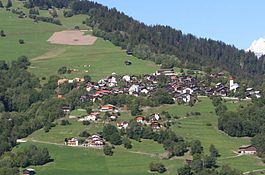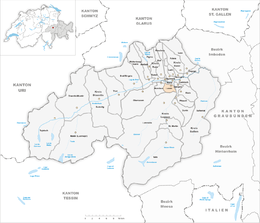Luven
| Luven | ||
|---|---|---|
| Former municipality of Switzerland | ||
 |
||
|
||
| Coordinates: 46°45′N 9°11′E / 46.750°N 9.183°ECoordinates: 46°45′N 9°11′E / 46.750°N 9.183°E | ||
| Country | Switzerland | |
| Canton | Graubünden | |
| District | Surselva | |
| Area | ||
| • Total | 6.83 km2 (2.64 sq mi) | |
| Elevation | 998 m (3,274 ft) | |
| Population (Dec 2011) | ||
| • Total | 199 | |
| • Density | 29/km2 (75/sq mi) | |
| Postal code | 7141 | |
| SFOS number | 3577 | |
| Surrounded by | Cumbel, Flond, Ilanz, Morissen, Sevgein, Surcuolm | |
| Website |
www SFSO statistics |
|
Luven (formerly known as Luvis) is a former municipality in the district of Surselva in the Swiss canton of Graubünden. On 1 January 2014 the former municipalities of Luven, Castrisch, Ilanz, Ladir, Pitasch, Riein, Ruschein, Schnaus, Sevgein, Duvin, Pigniu, Rueun and Siat merged into the new municipality of Ilanz/Glion.
Luven is first mentioned in 765 as Lobene.
The municipal coat of arms is a red field with a white Bible with black Alpha and Omega letters on it. It represents the conversion of the village to the Protestant Reformation.
Before the merger, Luven had a total area of 6.6 km2 (2.5 sq mi). Of this area, 52% is used for agricultural purposes, while 41.9% is forested. Of the rest of the land, 4.5% is settled (buildings or roads) and the remainder (1.7%) is non-productive (rivers, glaciers or mountains).
The former municipality is located in the Ilanz sub-district of the Surselva district. Before 2000 it was part of the Glenner district. It is located on the eastern slope of the Piz Mundaun. Until 1943 Luven was known by its German name as Luvis.
Luven had a population (as of 2011) of 199. As of 2008[update], 2.6% of the population was made up of foreign nationals. Over the last 10 years the population has decreased at a rate of -9.7%. Most of the population (as of 2000[update]) speaks the Sursilvan dialect of Romansh (59.6%), with German being second most common (35.0%) and Albanian being third (3.8%).
...
Wikipedia




